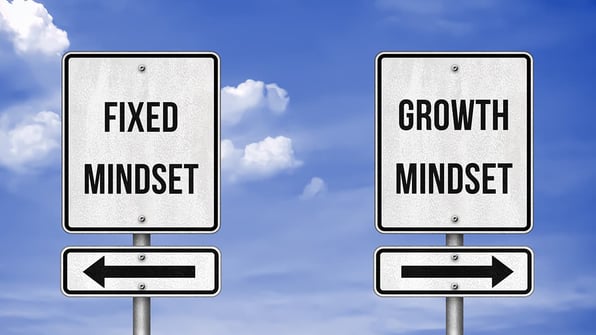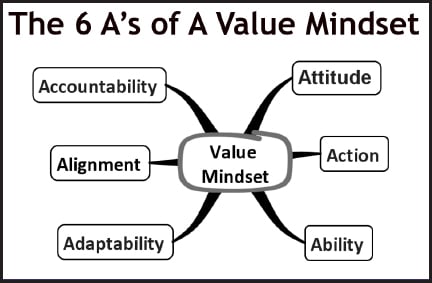The 6A Model of The Value Mindset

It’s time to consider possible ways to influence your value mindset and start moving the needle towards value excellence. The difficulty of value transformations is that you have to work at every level of the organization. Because customer value is dynamic and is a team sport, you must manage a complex system of various actions and activities working all at once. The goal is to achieve irreversible change at the organizational level while keeping in mind that change first happens at the individual level.
The 6A model shown below is a combination of individual and organizational change drivers. You have to work on all six at once and in parallel while accepting a fair amount of correlation among them. Statisticians would call that multi-collinearity as the drivers are influenced by the others.

Let us discuss the three as related to individuals.
- Attitude: It all starts here. What are the perceptions of pricing and value in your organization? Are team members positive and hopeful about your customer value programs or are they still pushing back? What is their body language during relevant meetings? You can interpret what their mindset is by checking in on their attitude at work. If you have issues in this first “A”, it will impact the rest of the model. You must address that very quickly and change perceptions.
- Action: The whole point of the transformation is to have people in action mode. They need to practice, practice and practice some more. Small baby steps are better than large overwhelming ones. Then, repeat the actions 100 times to improve the stickiness of the process and the outcome. It starts by developing an excellent value toolbox with plenty of things to do!
- Ability: Train all stakeholders on the basic and more advanced concepts of customer value management. That cannot happen in a meeting room only listening to presenters. Develop a progressive and hybrid learning program and adopt concepts of transformational and experiential learning. Training needs to also focus on repetition and on 10 touchpoints in a 4-to-6-month period. Consider more formal training like the DecisionLink Value Black Belt program.
At the same time, working on fundamental aspects of the organization must be done in parallel. - Adaptability: This is a key concept of mindset change. It is about being able to embrace the new and maintaining the existing. Some call this ambidexterity, but I prefer to keep things simple. Change will happen and a lot of it at once and for a while. It is the reality of value transformations. Leaders no longer have 10 years to transform and require transformation throughout the organization. They must accelerate the process.
- Alignment: Since it is a team sport, we must have a common playbook and game plan. The organization is fully mobilized and works in perfect alignment. That includes goals, objectives, metrics, compensations, priorities, etc. Alignment is also needed in language, definitions, and methods, especially in large organizations. It is not unusual for divisions to use different value selling methodologies or customer value management systems. Harmonizing all of these creates deep alignment. That alignment must start in the C-suite and trickle down the entire organization.
- Accountability: What happens when people do not change or when people openly resist the change process? That is a key question that needs to be answered by HR and top management. Do we tolerate nonperformance and resistance, or do we address it quickly and swiftly? Resistance and passive aggressiveness are like cancer that can spread rapidly in your organization. If you tolerate it too long, the organization might lose its momentum and be negatively impacted by resistors. In my experience with value transformation, some of the best performers in volume through discounting struggled and become last in terms of value and margin. They had to be managed carefully and eventually removed from their position.
In my 2017 Value Mindset [1] book I published in 2017, I offer an assessment to take to evaluate where you stand on the 6A model. It is a terrific way to get started and gauge your level of readiness to move to phase two of your value transformation. I recommend you select two or three dozen of your middle and top managers and ask them to take the survey. It will be certainly eye-opening.
Be bold! Join the customer value revolution!
Download this whitepaper to learn how to build a sales team with a Value Mindset.
Bio

Dr. Stephan Liozu (www.stephanliozu.com) is the Founder of Value Innoruption Advisors (www.valueinnoruption.com), a consulting boutique specializing in industrial pricing, digital business, and value models, and value-based pricing. Stephan has 30 years of experience in the industrial and manufacturing sectors with companies like Owens Corning, Saint-Gobain, Freudenberg, and Thales. He holds a Ph.D. In Management from Case Western Reserve University, and has written several books, including Dollarizing Differentiation Value (2016) and Value Mindset (2017).
[1] Amazon.com: Value Mindset: Accelerate Your Value Transformation By Changing Your Mindset eBook : Liozu, Stephan M.: Kindle Store

 ValueCloud
ValueCloud
.png?width=118&height=76&name=Rectangle%20(3).png) ValueCloud Ignite
ValueCloud Ignite
.png?width=92&height=92&name=Rectangle%20(4).png) Free Assessment
Free Assessment
.png?width=100&height=100&name=Rectangle%20(5).png) Watch a Demo
Watch a Demo
.png?width=82&height=96&name=Rectangle%20(6).png) Value Calculator
Value Calculator

.png?width=62&height=51&name=Group%2010%20(1).png) Marketing
Marketing
 Sales
Sales
 Customer Success
Customer Success
 Engage Prospects
Engage Prospects
 Win Deals Faster
Win Deals Faster
 Retain Customers
Retain Customers
.png?width=62&height=62&name=Rectangle%20(8).png) Adopt and Scale
Adopt and Scale
.png?width=54&height=54&name=Rectangle%20(9).png) Cybersecurity
Cybersecurity
 Healthcare
Healthcare
.png?width=54&height=54&name=Rectangle%20(10).png) IT & Software
IT & Software




